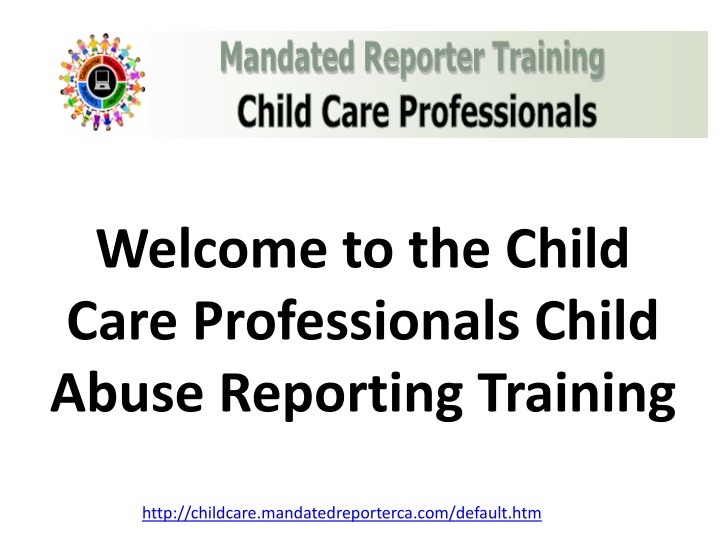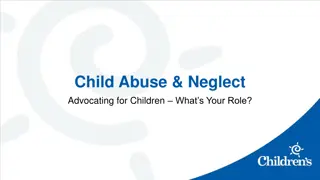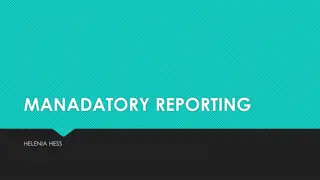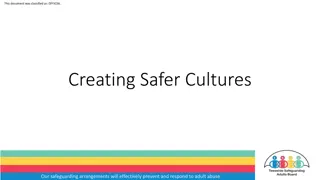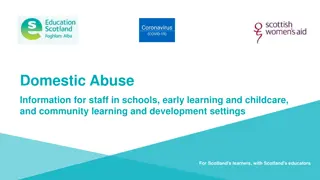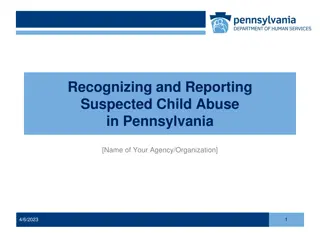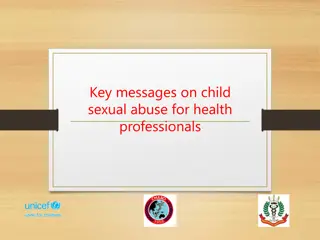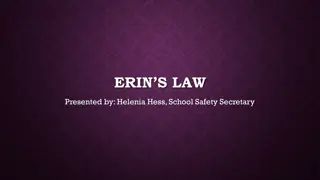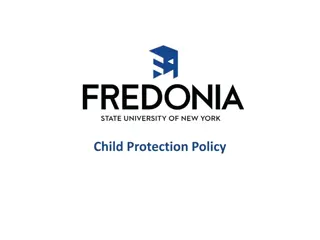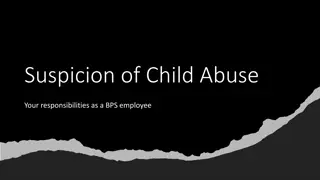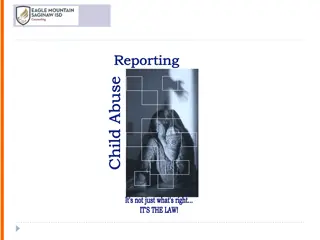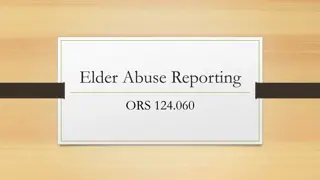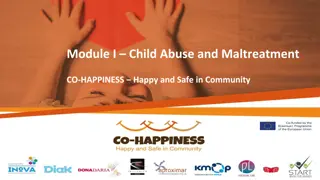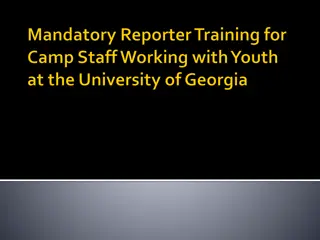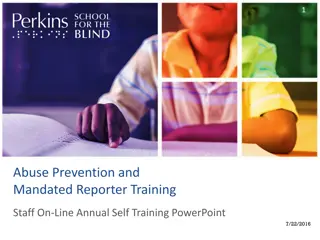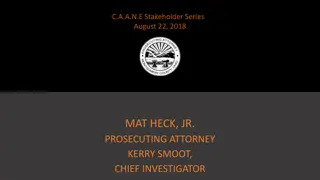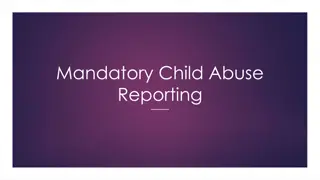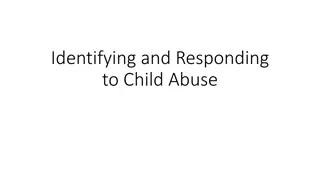Child Abuse Reporting Training for Child Care Professionals
Child Care Professionals are mandated reporters of child abuse and neglect. This training covers types of abuse, when to report, how to report, and the legal responsibilities involved in reporting suspected abuse. Failure to report can result in criminal consequences. Safeguards are in place to protect reporters who act in good faith. Immediate reporting by phone and filing of a written report are crucial steps to ensure child safety and compliance with the law.
Download Presentation

Please find below an Image/Link to download the presentation.
The content on the website is provided AS IS for your information and personal use only. It may not be sold, licensed, or shared on other websites without obtaining consent from the author.If you encounter any issues during the download, it is possible that the publisher has removed the file from their server.
You are allowed to download the files provided on this website for personal or commercial use, subject to the condition that they are used lawfully. All files are the property of their respective owners.
The content on the website is provided AS IS for your information and personal use only. It may not be sold, licensed, or shared on other websites without obtaining consent from the author.
E N D
Presentation Transcript
Welcome to the Child Care Professionals Child Abuse Reporting Training http://childcare.mandatedreporterca.com/default.htm
Types of Abuse The Penal Code specifies employment categories as mandated child abuse reporters. If your profession is one that falls in the category of a mandated reporter, you are required to report suspected abuse to local child protective authorities, either to Child Welfare Services or your Local Law Enforcement agency. To fail to report constitutes a crime. This requirement applies to: Physical abuse Neglect Sexual abuse Emotional abuse It is also important to remember that the responsibility for reporting rests solely with the mandated reporter. Reporting suspected abuse to an employer, supervisor, school principal, school counselor, coworker, or other person is not a substitute for reporting to a child protective agency. However, when two or more mandated reporters jointly have knowledge of suspected child abuse or neglect, a single report may be made by the selected member of the reporting team.
When to Report Child abuse must be reported when one who is a legally mandated reporter knows or reasonably suspects that a child has been the victim of child abuse or neglect. (P.C. 11166[a]). Reporting your concerns does not require certainty that child abuse or neglect has occurred, nor does it require a specific medical indication of child abuse or neglect; any reasonable suspicion is sufficient. This prevents delays in reporting, which can hinder investigations by authorities.
How to Report You must make a report immediately (or as soon as practically possible) by phone to your local Child Welfare Department or Law Enforcement Agency. A written report must be forwarded within 36 hours of receiving the information regarding the incident. The written report must be filed on Department of Justice Form SS 8572 (DOJ SS 8572), known as the Suspected Child Abuse Report Form. This form is available through county welfare departments, local law enforcement agencies or, in some instances, county probation departments. These forms and instructions are also available online at: (http://ag.ca.gov/childabuse/pdf/8583guide.pdf)
A person who fails to make a required report is guilty of a misdemeanor punishable by up to six months in jail and/or up to a $1,000 fine. He or she may also be subject to a civil lawsuit, and found liable for damages.
Safeguards for Mandated Reporters Those persons legally mandated to report suspected child abuse have immunity from criminal or civil liability for reporting as required, unless the report is proven to be false and the person reporting knows it is false, or the report is made with reckless disregard of the truth or falsity of the incident (P.C. 11172 [a]). No supervisor or administrator may impede or inhibit a report or subject the reporting person to any sanction (P.C. 11166 [f]). To do so is punishable by imprisonment, a fine, or both. Reports are confidential and may be disclosed only to specified persons and agencies (P.C. 11167.5) Mandated reporters and others acting at their direction are not liable civilly or criminally for photographing the victim and disseminating the photograph with the report (P.C. 11172 [a]) The primary intent of the reporting law is to protect the child. Protecting the identified child may also provide the opportunity to protect other children in the home. It is equally important to provide help for the parents. Parents may be unable to ask for help directly, and child abuse may be their way of calling attention to family problems. The report of abuse may be a catalyst for bringing about change in the home environment, which in turn may help to lower the risk of abuse in the home.
Under the Child Abuse and Neglect Reporting Act, child care professionals have specific information for mandated reporting for those who work in the following fields: An administrator of a public or private day camp An administrator or employee of public or private youth center, recreation program, or organization A licensee, administrator, or employee of licensed community care or child day care facility An employee of a child care institution (i.e. foster parents, group home personnel, personnel of residential care facilities) For the complete version of CANRA which includes the complete list of mandated reporters, see California Penal Code sections 11164-11174.3. https://bit.ly/2V0URJZ
As a child care provider, your regular contact with children gives you the chance to observe changes in appearance and behavior that may be indicators of child maltreatment. In addition, you may be the trusted adult to whom a child makes an initial disclosure of abuse. It is critical that all child care professionals know what to look for and how to proceed when child maltreatment is suspected. In this module you will learn: What to do if you discover evidence of child abuse or neglect How to talk to children about suspected abuse Special issues related to child abuse reporting for child care professionals
Child care providers play a vital role in helping children who are victims of child abuse or neglect. Your charges include the youngest children, who may not have the verbal ability to say what is happening to them. Child care providers must be observant in order to provide optimal care to children, measure progress and development, and document a child s strengths, needs, and interests. You have the opportunity to observe children s behavior over time, in a variety of situations, and in the context of other changes that may occur in the child s family life. As a result, your care-giving duties provide unique opportunities to observe behavioral changes that may be evidence of abuse. You may be the only person outside of the family with whom the child has significant contact, and therefore the only person who is in a position to help the child. However, reporting suspected abuse can be a delicate situation for the child care provider. The following lessons will consider mandated reporting from the point of view of the child care provider, and address some of the specific challenges and concerns that may arise.
What to Report Red flags for abuse and neglect are often identified by observing children s behaviors, recognizing physical signs, and observation of family dynamics during routine interactions with parents. Coercive parent-child interactions, limited positive parent-child interactions and heightened family conflicts may warrant further attention. In addition, poverty has been identified as a significant predictor of abuse, and can contribute to parent-child stressors and lack of mitigating social advantages. Reporting laws require a report be made when a mandated reporter has a reasonable suspicion of abuse. This criterion is intended to ensure that a maximum number of abused children are identified and protected. It is important to understand that, legally speaking, mandated reporters only need reasonable suspicion rather than hard evidence or proof to report suspected child abuse. Judging what constitutes a reasonable suspicion in practice, however, can be difficult. In the absence of clear physical indicators or verbal reports of abuse, child care providers must rely on direct observations of children and families to determine when a report should be made.
What to Report With regard to behavioral indicators, keep in mind that children react differently to being abused, and many abused children do not exhibit behavioral symptoms. The presence of behavioral changes or indicators (e.g., wariness of adults, discomfort when other children cry, fear of parents or of going home) does not prove that a child is being abused, but should serve as a warning signal to look further. Physical Abuse Physical abuse often involves physical signs specific to the abuse, with absent or inconsistent explanations. Heightened aggression and poor anger management, especially toward other children, are the most documented behavioral consequences in victims of physical abuse. Vignette 1 Three-year-old David arrives at daycare tearful and upset. You notice that he has a red mark on his face and appears to be favoring his left arm. His mother explains that he is fine, and is crying because he got in trouble for wetting his pants and making them late. You ask the child if any parts of his body hurt, and he indicates his arm, but does not provide a verbal response. When you ask how he got hurt, he appears frightened and does not answer you. Although you have had concerns about David s care in the past, this is the first time you have noticed possible injuries. What should you do?
You must make a report of suspected child abuse; David should be seen by a doctor to evaluate for possible physical abuse, and further assessment needs to be done to ensure his safety.
Vignette 2 You run a family daycare, and care primarily for infants. When changing the diaper of a six- month-old, you notice bruising on her buttocks. When you look further, you also notice scratch marks and bruising on her back as well. What should you do?
You must make a report of suspected child abuse. The location and nature of the injuries should alert you to possible abuse, and bruises of any kind are uncommon in infants and should raise suspicion.
Sexual Abuse The single most important indicator of sexual abuse is disclosure by the child. However, it can be difficult for older children to report sexual abuse due to the nature of the abuse, the guilt and shame of the child victim, and the possible involvement of parents, stepparents, friends or others in a caretaker role. It is not unusual for children to delay weeks, months, or even years before disclosing sexual abuse. In addition, sometimes a child who seeks help is accused of making up stories. Many people may not believe the victim because the abuser is well- liked and others cannot believe he or she could be capable of sexual abuse. When the matter does come to the attention of authorities, the child may give in to pressure from parents or caretakers and deny that sexual abuse has occurred. The child may feel guilty about "turning in" the abuser or breaking up the family, and recant or change his or her story.
Sexual Abuse Although this pattern of denial is typical, it may result in skepticism when a child discloses sexual abuse. The sad reality of sexual abuse is that without third-party reporting, the child often remains trapped in secrecy by shame, fear, and threats by the abuser. It is therefore important to recognize that children rarely fabricate these accounts; they should be taken seriously. In younger children, sexual abuse is often suspected when behavioral changes or indicators are observed. Red flag behaviors indicative of possible sexual abuse include: withdrawal, enuresis, sexually explicit drawings and/or comments, and sexualized behavior and/or knowledge beyond developmental expectations. When assessing behavioral indicators, it is crucial that the child care provider be knowledgeable about normative sexual behavior in children.
Vignette 3 You become concerned because 8-year-old Sara, a student in your after- school program, is caught exposing herself to other children and telling them to touch her. You talk with her about this behavior, and she informs you that her 14-year-old brother always wants to see her pee pee and likes to touch it. What should you do? A. Call Sara s parents to tell them what she said and to find out more about her brother. B. Nothing. Sara does not seem upset and you do not want to over- react. C. Make a child abuse report for possible sexual abuse. D. Tell your supervisor of your concerns and hope that s/he will take the appropriate action.
Vignette 4 You provide care for three-year-old Nancy, who is bright and engaging. However, you notice that recently her behavior has changed; she touches herself excessively and has been caught trying to insert toys into her vagina. When you talk with her mother about your concerns, she tells you of behavioral changes that she has observed. She explains that Nancy has been wetting the bed and wakes frequently during the night. She thinks this behavior began after Nancy started visiting her father, who recently got out of prison. She says that when she asks Nancy about the visits, she replies, I can t tell you, or Daddy will be mad at me. She says she does not know what to do, and asks your advice. What should you do?
You should explain your role as a mandated reporter to Nancy s mother, and advise her that, although her child has not made a disclosure of abuse, a suspected child abuse report should be made so that a protective services worker can be assigned and the concerns evaluated further.
Neglect Possible symptoms of child neglect are often difficult to identify as they are less defined than those for physical or sexual abuse. In addition to the behaviors noted previously, social withdrawal is most often associated with neglect. Internalized emotional symptoms such as anxiety and depression may also be evident. The child s description of his or her living situation and direct observation may be necessary to identify sufficient circumstances for reporting suspicions of neglect. It is important to remember, however, that these indicators should be evaluated in the context of the family s culture, values and economic situation.
Vignette 5 A four-year-old girl in your daycare often complains that she is hungry, saying that she does not eat at her house. She frequently asks you for extra food to take home for later. You also notice that her clothing is often inappropriate for the weather, and she appears dirty and unkempt. She does not play with the other children, and rarely laughs or smiles. You have tried to speak with her mother about your concerns, but she is usually in a hurry and seems to resent your intrusion. What concerns would you have about this child? A. Possible general neglect B. Possible economic hardship C. None D. Both A and B
Emotional Abuse Although emotional abuse is not as clearly defined in the law as other forms of maltreatment, it is generally recognized as a pattern of behavior by a caretaker that impairs a child's emotional and/or psychological development. Examples include: constant criticism, threats, rejection, intimidation or humiliation, acts intended to produce fear or guilt, withholding of love and support, and isolation. Witnessing of domestic violence also falls within the scope of emotional abuse. Reasonable suspicion of emotional abuse that must be reported often results from verbal disclosures or direct observation and involves any person willfully causing or permitting any child to suffer unjustifiable physical pain or mental suffering, or endangering the child s person or health. (Penal Code 11165.3)
Emotional Abuse In the absence of a verbal disclosure or direct observation, suspicions of abuse may be reported when behavioral indicators alert the professional to suspect emotional abuse. Emotional and behavioral problems, in varying degrees, are common among children whose parents abuse them emotionally. Attention deficits, school difficulties and poor social skills are among the most common. Penal Code 11166.05 provides that, Any mandated reporter who has knowledge of or who reasonably suspects that a child is suffering serious emotional damage or is at a substantial risk of suffering serious emotional damage, evidenced by states of being or behavior, including, but not limited to, severe anxiety, depression, withdrawal, or untoward aggressive behavior towards self or others, may make a report These emotional and behavioral patterns may, of course, be due to other causes, but the suspicion of abuse should not be dismissed. Emotional abuse is often difficult to prove; cumulative documentation by a child protection agency may be necessary for effective intervention. Finally, emotional abuse is most often reported along with concerns of other types of abuse; any child who is being physically abused, sexually abused, or neglected is also being emotionally abused.
Vignette 6 While working at a summer program for youths, you become concerned about 12-year-old Nancy, who appears depressed and withdrawn. When talking about her family, she says that her father often criticizes her behavior and appearance, calling her stupid, lazy and fat. She also comments that, although she likes attending the youth program, she worries about being away from her mother because her father has started drinking again and is sometimes violent when he is drunk. Would you make a suspected child abuse report based on this information? not report suspected abuse based on this information? like to obtain more information before reporting?
If you chose to make a suspected child abuse report based on this information: It is appropriate to make a report. Nancy s affect and verbal description fall into the category of emotional abuse that may be reported. In addition, there may be more to the situation than what a child initially discloses, and ethical and moral obligations to protect children should supersede the letter of the law. If you chose to obtain more information before reporting: Although you have enough information, based on Nancy s affect and verbal description, to make a report of suspected emotional abuse at this time, there may be more to the situation than what she has disclosed. Assessing for other risk factors would be an appropriate course of action, as long as you do so within your professional role and level of training.
Ethical and Legal Considerations This lesson will cover the legal and ethical issues relevant to mandated reporting, as well as some practical information about what you should do when you suspect a child has been abused or neglected. At the end of this lesson, you should: Be familiar with guidelines to aid you in deciding whether or not to make a report. Know what steps to take when you suspect a child is being abused/neglected, including how to talk with the child about your concerns. Be familiar with some of the obstacles to reporting and how to overcome them. Understand what may happen after the report is made.
Deciding When to Report When establishing thresholds for reasonable suspicion , it is important to remember that verbal disclosures of abuse surpass reporting thresholds and should always be reported. When suspicions arise based on behavioral concerns or other more subtle cues, child care providers are ethically obligated to explore their concerns in order to determine whether a report is warranted. However, it is important that child care providers work within the scope of their training and expertise. Investigating concerns of abuse (for example, conducting interviews or physical examinations), making judgments about the validity of a disclosure, and evaluating the safety of the child are best left to the investigative agencies. Documentation is an important tool for child care providers. Written records of observations made while caring for a child are used to inform parents of the child s routines and experiences while in care. If the provider notices changes in the child s behavior, a review of the records may be helpful in tracking the changes as well as establishing possible causes. You may also decide to contact a child s parent to discuss your concerns.
Deciding When to Report Although contacting a parent may be helpful in evaluating behavioral changes or concerns, it may not be appropriate to contact the child s parents/caretakers in situations where you suspect a child has been abused or neglected or a child has made a disclosure of abuse. Deciding whether or not to tell a parent that you plan to report or already have reported child abuse can be a difficult decision. Although there are no legal guidelines for mandated reporters to follow in making this decision, keep in mind that your first priority is establishing the safety of the child. Any information that suggests that informing the parents could increase the risk of further abuse to the child should be considered. Also, be aware that such action could interfere with the initial CPS investigation. For example, a parent might intimidate a child into recanting allegations, remove the child from your program, and/or flee to avoid contact with investigators. When a provider suspects child abuse or neglect, but does not feel that the suspicions surpass his or her threshold for reporting, consultation with the local child protection agency should be sought in order to assist in decision-making.
What to do if you suspect abuse Possible indicators of various types of child abuse and neglect have been provided. If you observe these warning signs, it is important to keep detailed notes of your observations. Be aware that these records may be subpoenaed if there is a child abuse or neglect investigation, so it is important that they are clear and objective, and contain facts rather than opinions. Whether you are discussing your concerns with a colleague or making a report to a child protective agency, written notes will be very helpful. Remember, it is not your role to investigate whether or not a child is abused; it is your responsibility to report suspected abuse.
What to do if you suspect abuse Child care providers should establish protocols detailing how suspected maltreatment is to be reported to CPS. These protocols should delineate what information is needed for the report, as well as actions to be taken both during and after a report is made. Parents should also be informed, during initial enrollment, of the provider s legal responsibility to report child maltreatment.
What to do when you suspect that a child in your care is being abused Control your emotional response. Remain calm Do not express shock, disapproval or disgust regarding the child, parent or disclosure When talking with the child: Assure the child that what they tell you will not be shared with other children or with anyone who does not need to know Inform the child that it may be necessary to discuss the information with other adults who can help Conduct the discussion in private Sit next to the child, rather than behind a table or desk Conduct the discussion in language the child understands Allow the child to tell you of their experience in their own words using narrative prompts (i.e., Tell me about ) and open-ended questions.
What to do when you suspect that a child in your care is being abused Consider other observations you have made of the child and the parent(s). Have there been other clues that something is wrong? Has there been a pattern of abuse? If what you have seen or heard falls under the legal definition of child abuse/neglect, it must be reported. If you are unsure whether what you have seen or heard is abuse/neglect, call a child protective agency for advice.
Vignette 1 You are concerned about a third-grade student in your after-school program who has exhibited behavioral changes. Although she has always been a good student, you notice that she no longer works on her homework. She frequently appears tired and no longer socializes with her friends. You decide to talk with her about your concerns. Which of the following is not appropriate when talking with your student: A. Conduct the discussion in private. B. Allow the child to tell you of her experience in her own words. C. Reassure the child that you will not tell anyone what she tells you. D. Do not express shock, disapproval or disgust.
Talking with Children You may become aware that one of the children in your care is a victim of abuse by observing physical evidence, by the child s behavior, or by the child s verbal disclosure. If you observe physical evidence of abuse, employ only open-ended questions in asking the child about it. For example, if a child displays unusual bruising, ask How did you get hurt? rather than Did your father do that? or Who hit you? If it is the child s behavior that concerns you, ask the child privately whether there is anything going on at home or at the child care facility that is making the child angry or unhappy. Among younger school-age children, verbal disclosures sometimes occur by accident, or the child may tell another child who then tells you. However it is disclosed, the concerns must be reported, even if the child later recants his or her statements. It is very common for a child who discloses abuse to then deny it out of fear of getting in trouble or of breaking up the family.
Talking with Children It is important to reassure the child that: He or she is not to blame for the abuse. He or she deserves praise for having the courage to reveal the abuse. He or she is helping the family by seeking outside help Let the child know what you will do as a result of the disclosure, explaining who you will tell and why.
Obstacles to Reporting One of the biggest obstacles to reporting may be the feelings of the reporter. It is important to remember that the intention of a child abuse report is to protect a child, not punish the family. When a report is made, child protective agency workers can investigate and, when appropriate, intervene to provide services and education for parents. While child care workers relationships with children and families enable them to detect possible indicators of abuse or neglect, these relationships can also make reporting more difficult. Providers may be friends or family members, and child care agency professionals often establish special relationships with families. However, reluctance to report in these situations must be overcome as child care providers are legally mandated to report suspected maltreatment, and are ethically required to protect children.
Obstacles to Reporting Concerns about the caretaker s reaction to the report can also be a deterrent to reporting, and should be addressed. Although the identities of mandated reporters are confidential, providers worry about repercussions, including being confronted by angry parents or losing income, should their role as a reporter become known. Remember that involvement with investigatory agencies is often a confusing and perplexing experience for parents or caregivers. When confronted with an angry parent, it is important to remain calm, and maintain a professional demeanor. Listening to and normalizing a parent s feelings while expressing appropriate concern and respect may help diffuse the situation. Informing the parent of your status as a mandated reporter during the enrollment process may also help to alleviate some of this concern.
After the Report is Made It may be necessary for a CPS investigator to interview the child at the child care facility. If so, a private place should be provided so that the child can feel comfortable and safe when talking with the worker. Child protection workers and/or law enforcement officers may contact you to gather additional information to aid in their investigation. As a child care professional, you may have knowledge about the child and/or family which can aid the investigators in making accurate assessments and providing appropriate services.
After the Report is Made In situations when the child care provider is contacted by the parent or caregiver regarding a report, it is important to: Respond in a professional, direct and honest manner Avoid revealing information pertinent to the child abuse report/investigation Avoid betraying the child s confidence (e.g., Sarah said ) Inform the parent, if necessary, that the current conversation may not be kept confidential (any threats or admissions of maltreatment must be reported) Finally, in cases where a report is unsubstantiated, or the provider has concerns that do not rise to his or her reporting threshold, keeping a confidential written record of concerns and observations is crucial. Over time, such a record might indicate a pattern of abuse or behavioral indicators that should then be reported.
Testifying in Court Substantiated cases of child abuse and neglect may be litigated in criminal court, family court, juvenile court, and other legal arenas. When these cases go to court, mandated reporters may be asked to provide testimony. You may receive a subpoena requiring you to appear in court to testify as to the context and content of the child s disclosure of abuse, as well as your knowledge of the child and family. It is important to be familiar with your agency s procedures for receiving and responding to subpoenas.
Special Situations This lesson will cover situations specific to child care professionals. At the end of this lesson, you should be able to: Be aware of licensing and reporting requirements for workers in child care programs. Be aware of issues regarding child abuse in the child care setting. Know what to do if you suspect a colleague has done something that could be considered abusive or neglectful.
Child Care Licensing Although the regulations for Family Child Care and Child Care Centers in California are somewhat different, both require that new child care workers obtain a criminal record clearance or exemption and also complete the Child Abuse Central Index (CACI) check. According to Title 22, Division 12, Chapter 3 of the Manual of Policies and Procedures for Community Care Licensing, licensees must report to the Department by telephone or fax any child injury requiring medical treatment; any unauthorized child absence; any suspected child abuse or neglect; . The initial report must be followed by a written report within seven days.
Child Care Licensing Licensees are also required to notify a child s parent or authorized representative, as soon as possible but no later than the same business day, of any injury suffered by a child in care, any cases of violence in the home, and any dangerous activity such as illegal drug use or gunfire. http://ccld.ca.gov/res/pdf/RegHighlightsEnglish.pdf Reports made to the Department of Social Services, Community Care Licensing, are supplemental to reports that must be made to local child protection agencies in cases of suspected child abuse and neglect. Reporting to Community Care Licensing alone does not fulfill the mandated reporting requirements for child abuse and neglect. For more detailed information regarding child care licensing, go to http://www.cdss.ca.gov/inforesources/Child-Care-Licensing
Cross-Cultural Considerations Child care providers often care for children whose ethnic or racial background is different from their own. Providers should become educated about the culture(s) with whom they have frequent contact, and avoid classifying or labeling individuals based on cultural preconceptions. It is important to keep in mind cultural influences when assessing information or behavior, and to avoid allowing personal beliefs or biases to influence decision-making. Cultural differences may become evident in various aspects of child-rearing. For example, a family might have an attitude towards nudity that is more relaxed than is typical, but that in itself does not indicate sexual impropriety. The same can be said for family sleeping, which is common in some cultures. Parents might choose alternative forms of medicine for their children, including religious or spiritual healing, but this does not necessarily constitute neglect (P.C. 11165.2). While some families believe corporal punishment of children is unacceptable under any circumstances, other families have a highly authoritarian structure and consider physical punishment, such as spanking, an acceptable disciplinary measure. However, if a disciplinary practice falls within the legal definitions of child abuse, it must be reported.
Red Flags for Abuse in the Child Care Setting Although there are many protections in place to help ensure the safety of children in the child care setting, it is important to be aware that abuse and neglect in daycare settings does occur, and accounts for up to three percent of all confirmed cases in a given year. Child care professionals should be educated about child development in order to establish age-appropriate expectations and discipline. Child care professionals are never to use corporal punishment, even if they have the parents permission to do so.
Red flag behaviors to be aware of in the child care setting are similar to parent indicators covered in the general training, and include: - Provider has unrealistic expectations of the child - Provider is unduly harsh or rigid - Provider berates, humiliates or belittles a child - Provider yells or screams at children - Provider exhibits inappropriate interest in a specific child - Provider engages in inappropriate physical contact (e.g., forcing a child to hug or kiss him/her) Supervisors who witness inappropriate behaviors by child care staff should document observations, and should meet with the staff member to address their concerns and establish a performance improvement plan. Termination of the staff member may be necessary if behavior that is detrimental to the children does not improve.
Physical Contact With Children As adults in constant contact with children, child care providers must be aware of what is considered appropriate vs. inappropriate physical contact with children. Physical contact can be a positive gesture or affirmation when used appropriately. It is important to realize, however, that what is considered appropriate varies between individuals and is affected by such factors as age, gender, personal experience and cultural background. Touching is always a concern if it is done in secrecy or isolation from others or for the sexual gratification of the adult, and children need to be informed and empowered about what is appropriate and inappropriate touching.
When Abuse is Suspected in the Child Care Setting As a child care provider, you and other staff are responsible for the well-being and safety of the children in your care. If you become aware that a colleague has done something that could be considered abusive or neglectful, you are required to report your suspicions. In addition, termination of the staff member may be required. It is important that you be knowledgeable about appropriate termination procedures.
Vignette 1 You are the director of a summer daycare. At the end of the summer, the parent of one of the children in your program contacts you because she is concerned about the behavior of Paul, a college student who volunteered in your program. She says that John, her 11-year-old son, told her that Paul frequently made him sit on his lap, and rubbed John s back and thighs. She tells you that John said this made him feel uncomfortable, and that he tried to refuse but that Paul insisted, and sometimes offered to bring him a special treat the next day. What should you do? A. Make a suspected child abuse report. B. Talk with Paul to find out if this is an accurate report. C. Ask John s mother to bring John to see you so that you can talk to him. D. Nothing. Paul is not part of your regular staff, and you don t want to raise concerns unnecessarily.
How should I decide whether or not to report suspicions of child abuse? Reporting should be done when a person either knows or suspects that a child has been or is in danger of abuse or neglect. Hard proof is not needed to make a report. The standard by which a report should be made is reasonable suspicion . Reasonable suspicion means that it is objectively reasonable for a person to entertain a suspicion, based upon facts that could cause a reasonable person in a like position, drawing, when appropriate, on his or her training and experience, to suspect child abuse or neglect . (Penal Code 11166 (a) (1)). Verbal disclosures of abuse should surpass reasonable suspicion thresholds. However, reports must be made in good faith. Use common sense. A report of child abuse is serious and may have a lifelong impact on the child and his or her family. Never make a false or malicious report. If you are in doubt at all about whether to report a particular situation, consult with a colleague and/or telephone the child abuse hotline at your local child protection agency in the county social services or probation department and discuss the situation.
